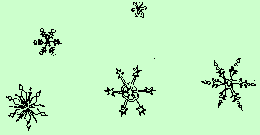|







|
. |
Snow and Snowflakes

 Snow is a solid crystalline form of water. Water is the only common
mineral that expands when it freezes, instead of shrinking. When it is
solid, as in snow or ice, it has a distinct six-sided (hexagonal)
crystalline pattern. The crystal form depends on atmospheric conditions.
The higher the temperature, the more branching the pattern; the greater
the humidity, the faster growth of the crystal. As the snow-fall becomes
a blanket, one may observe the process of sedimentation just as in a rock
formation.
Snow is a solid crystalline form of water. Water is the only common
mineral that expands when it freezes, instead of shrinking. When it is
solid, as in snow or ice, it has a distinct six-sided (hexagonal)
crystalline pattern. The crystal form depends on atmospheric conditions.
The higher the temperature, the more branching the pattern; the greater
the humidity, the faster growth of the crystal. As the snow-fall becomes
a blanket, one may observe the process of sedimentation just as in a rock
formation.

 Snow can be a dangerous situation ... it can make roads and walkways
slippery. Its heavy weight can break limbs from trees, cause power-line
damage, cause avalanches, and affect a whole community. The accumulation
of snow causes glaciers to form, which have changed the shape of the
earth's surface. But it can also do a great deal of good. Snow from our
mountains provides water for us during our summers. Slowly released into
the ground, it provides underground reservoirs. It provides a warm
blanket for plants which protects them from excessive changes in
temperature. In the forest, it prunes woody plants and helps to protect
animals. It is a source of recreation for man, as we see in our mountains
for skiing and snowshoeing. It is also a source of great beauty, a
pleasure to behold.
Snow can be a dangerous situation ... it can make roads and walkways
slippery. Its heavy weight can break limbs from trees, cause power-line
damage, cause avalanches, and affect a whole community. The accumulation
of snow causes glaciers to form, which have changed the shape of the
earth's surface. But it can also do a great deal of good. Snow from our
mountains provides water for us during our summers. Slowly released into
the ground, it provides underground reservoirs. It provides a warm
blanket for plants which protects them from excessive changes in
temperature. In the forest, it prunes woody plants and helps to protect
animals. It is a source of recreation for man, as we see in our mountains
for skiing and snowshoeing. It is also a source of great beauty, a
pleasure to behold.
 HOW TO CATCH SNOWFLAKES
HOW TO CATCH SNOWFLAKES

 Materials needed:
Materials needed:

 Several pieces of clean glass --- microscope slides 1" x 2" are a good size.
Several pieces of clean glass --- microscope slides 1" x 2" are a good size.

 A holder --- a piece of insulating material such as wood, at least 4" x 6".
The lid of a styrofoam picnic box would be excellent.
A holder --- a piece of insulating material such as wood, at least 4" x 6".
The lid of a styrofoam picnic box would be excellent.

 Plastic spray --- Krylon Crystal clear spray is recommended. I think a
clear acrylic spray would probably work okay.
Plastic spray --- Krylon Crystal clear spray is recommended. I think a
clear acrylic spray would probably work okay.

 Procedure: Have all above materials as cold as possible. They can
be kept out-of-doors in a plastic bag or box. Place several pieces of
glass on the wood holder. (If the glass is held in the hand, the heat from
your fingers may melt the snow crystals.) Spray an even coating of plastic
on each piece of glass, tilting the holder to get rid of excessive spray.
Expose the glass to falling snowflakes until several have fallen on each
piece of glass. Place in a cold ventilated place, such as a porch or shed
for 15 minutes, or until the solvent has evaporated. The plastic spray
will replace the snow, leaving a permanent white plastic snowflake. They
are very delicate, and should not be handled roughly. They can be examined
with a hand lens or microscope, and can be carefully stored in a box.
LeRoy Behling has experience with this, and you might get in touch with him
if you need more help.
Procedure: Have all above materials as cold as possible. They can
be kept out-of-doors in a plastic bag or box. Place several pieces of
glass on the wood holder. (If the glass is held in the hand, the heat from
your fingers may melt the snow crystals.) Spray an even coating of plastic
on each piece of glass, tilting the holder to get rid of excessive spray.
Expose the glass to falling snowflakes until several have fallen on each
piece of glass. Place in a cold ventilated place, such as a porch or shed
for 15 minutes, or until the solvent has evaporated. The plastic spray
will replace the snow, leaving a permanent white plastic snowflake. They
are very delicate, and should not be handled roughly. They can be examined
with a hand lens or microscope, and can be carefully stored in a box.
LeRoy Behling has experience with this, and you might get in touch with him
if you need more help.
Modified by Dot Platt from an article,
How to Catch Snowflakes,
published in a 1963 issue of
THE CURIOUS NATURALIST
Have you ever noticed how the snow melts in different places? Our patio
has red and white cement tiles. Snow always stays longer on one color.
Which do you think it is? Try different colors, white, red, and black,
and see on which one the snow melts first, and which the last.
|
|

